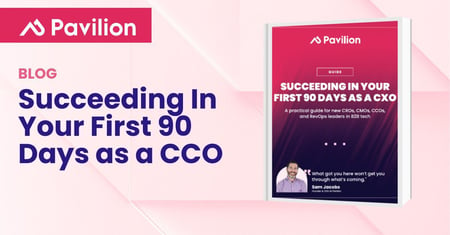
If you’ve just stepped into a CMO role at a B2B company, congratulations. Welcome to one of the most visible, misunderstood, and high-pressure jobs in go-to-market leadership.
You’re likely inheriting more than a team. You’re inheriting a brand and a reputation. In many cases, a perception problem. Either Marketing has been underpowered and siloed, or it’s been over-promising and under-delivering. Regardless, expectations are high, and the clock is ticking.
The modern CMO is expected to be a revenue driver, brand steward, strategic partner to Product, and the glue between Sales and the rest of the org. At the same time, you’re proving ROI, managing tech complexity, and navigating rapidly evolving buyer behavior. Your job over the next 90 days is to reset the narrative. Not just externally, but internally. This is your window to reposition Marketing as a strategic growth engine.
If you want a structured playbook for doing that, one built by Pavilion’s global community of GTM leaders, read our complete guide: Succeeding in Your First 90 Days as a CMO.
Your first job isn’t to launch a campaign. It’s to listen. Deeply and cross-functionally.
Start with your executive peers. Ask questions like:
You’ll uncover a wide spread of expectations. Often unspoken. Usually misaligned. Don’t try to solve everything yet. Instead, focus on where the tension lies. Is it messaging? Attribution? Brand trust? Lead quality?
Simultaneously, conduct a full-funnel audit:
Internally, audit your team: roles, responsibilities, duplication, blind spots. Who owns what? Who are your builders? Where’s the complexity? Where’s the drift?
Don’t move fast for its own sake. Move accurately. Success in this phase comes from demonstrating that you’re here to understand before you execute.
For additional guidance from top operators on the full-funnel evaluation, Pavilion’s CMO School gives you practical frameworks and peer insight from marketing leaders who have done this exact work in high-growth environments. It's built for CMOs navigating exactly this moment.
Now it’s time to socialize your perspective. Define what Marketing should own, what it can influence, and what it needs from other teams.
Pressure-test that perspective with your executive peers. Especially Product, Sales, and RevOps. Don’t pitch. Co-develop.
This phase is also about internal marketing. If your peers don’t understand what Marketing does and why it matters, they won’t support your strategy. Even if your campaigns work.
Erica Seidel, founder of The Connective Good, puts it this way: “Some of the most successful CMOs I know recommend tuning your beginner’s ear to the market and sharing early hypotheses with the Board. That sets the tone for you to become the expert on the customer and participate in boardroom dialogue rather than just answering questions.”
Simultaneously, she reminds us: credibility compounds. "The rhythm of strategy, execution, measurement, and iteration builds trust. Start that rhythm early."
To understand how Marketing and Sales leaders create that rhythm together, watch Pavilion’s webinar Scoring Big: The Playbook for Effective CRO and CMO Alignment. It features real-world examples of top-down alignment, shared goals, and how to build momentum between two of the most visible GTM functions.
Your third month is about momentum. You’re not expected to deliver full-funnel growth yet. But you are expected to prove that your approach is working.
Now is also the time to shape culture. Are you modeling data fluency? Strategic clarity? Bold creativity? Your team takes its cue from you. Make sure you’re showing the mindset you want them to emulate.
Most importantly, begin to lead beyond your function. CMOs today must speak the language of revenue, CAC, retention, margin, and roadmap. Your credibility in the C-suite depends on it.
For a candid discussion of what that credibility looks like in practice, check out The B2B Marketing Identity Crisis episode of Pavilion’s Topline podcast. Sam Jacobs, Asad Zaman, and AJ Bruno break down what modern marketing is, and isn’t, in high-performing GTM orgs.
You weren’t hired to run campaigns. You were hired to restore clarity. In your message, your metrics, and your mandate.
Modern B2B buyers are overwhelmed. Sales cycles are long. Differentiation is hard. Marketing is the function that can cut through that noise and tell the truth about who you are, what you do, and why it matters.
If you can establish that clarity in your first 90 days, you don’t just prove that marketing works. You prove that marketing leads.
Building your onboarding plan now?
Don’t start from scratch. Download our 30-60-90 day CMO onboarding checklist to get a head start.

